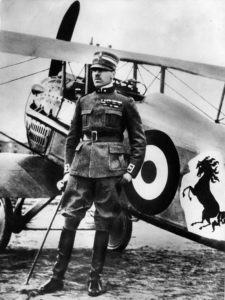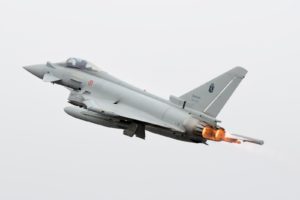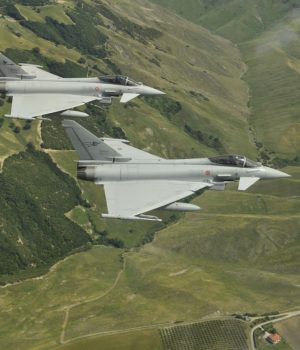Da circa 100 anni il cavallino rampante lega indissolubilmente la scuderia Ferrari e l’Aeronautica Militare, un connubio che fonda le sue radici storiche durante la prima guerra mondiale, con le gesta dell’Asso degli Assi dell’aviazione, il maggiore Francesco Baracca.
Per questo, per celebrare il Gran Premio numero 1000 della scuderia Ferrari in Formula 1, domenica 13 settembre l’Aeronautica Militare aprirà il GP di Toscana Ferrari 1000 con il sorvolo di una formazione di caccia Eurofighter che, proprio come lo SPAD S.XIII di Baracca, riportano sulla fusoliera il cavallino rampante, simbolo che ancora oggi caratterizza i reparti di volo della Forza Armata che quotidianamente assicurano la Difesa dello spazio aereo nazionale e della NATO.
In particolare si tratta di caccia intercettori Eurofighter appartenenti al 9° Gruppo Volo del 4° Stormo di Grosseto ed al 10° e 12° Gruppo Volo del 36° Stormo di Gioia del Colle (BA).
Ancora una volta il legame tra il mondo dei motori della Formula 1 e l’Aeronautica Militare si rinnova. Solo lo scorso 6 settembre, infatti, i velivoli MB-339PAN delle Frecce Tricolori hanno steso il Tricolore sul Gran Premio d’Italia 2020 a Monza poco prima della partenza della gara.
Motori e velocità, ma anche tecnologia, innovazione e soprattutto spirito di squadra, elementi cardine che accomunano i Reparti di volo dell’Aeronautica Militare e le scuderie della Formula 1.
SCHEDA – La storia del Cavallino Rampante
Il cavallino rampante – di colore argenteo su campo rosso, rivolto a sinistra e con la coda abbassata – era lo stemma araldico del “Piemonte Reale Cavalleria”, uno dei più prestigiosi reparti dell’Esercito Italiano, presso il quale Francesco Baracca prestò servizio ad inizio del Novecento.
Di lì a poco, il giovane cavallerizzo volle diventare aviatore e fu proprio il suo amore per i cavalli che lo portò negli anni successivi a scegliere di adottare, sebbene con alcune varianti, lo stesso stemma quale simbolo per i suoi aeroplani. Il cavallino rampante nero apparve per la prima volta su di un aeroplano pilotato dall’asso a inizio 1917 e divenne definitivamente l’insegna applicata sulla fusoliera degli aerei da lui pilotati nell’ambito della neo-costituita 91ª Squadriglia.
Il 19 giugno 1918 Francesco Baracca non rientrò da un volo di guerra sul Montello e il suo corpo fu trovato solo alcuni giorni più tardi accanto ai resti bruciati dello SPAD su cui volava.
Da quel momento, furono i genitori dell’Asso a tenerne vivo il ricordo e fu un incontro – il 16 giugno 1923 durante il Circuito del Savio – tra il padre di Francesco Baracca, Enrico, e un giovane Enzo Ferrari (all’epoca al volante di un’Alfa Romeo) a preparare la strada a quello che diventerà un mito a livello mondiale.
A quell’incontro seguì quello tra la madre di Francesco e il costruttore modenese, al quale la contessa Paolina Biancoli donò il prezioso emblema accompagnandolo con queste parole: “Ferrari, metta sulle sue macchine il cavallino rampante del mio figliolo. Le porterà fortuna”.
“Conservo ancora la fotografia di Baracca, con la dedica dei genitori con cui mi affidano l’emblema” – scriveva Enzo Ferrari il 3 luglio 1985 allo storico lughese Giovanni Manzoni – “Il cavallino era ed è rimasto nero; io aggiunsi il fondo giallo canarino che è il colore di Modena”.
Il Cavallino Rampante tornò ad apparire come stemma della 91ª negli anni ’20, per ricevere poi una definitiva consacrazione quale insegna del 4º Stormo della Regia Aeronautica per volere di Amedeo d’Aosta che allora lo comandava. Lo stesso stemma fu inoltre impiegato per un periodo anche sulle moto Ducati, su richiesta dell’allora progettista Fabio Taglioni, originario di Lugo di Romagna. Il cavallino rampante vola tuttora sul timone di coda degli Eurofighter dell’Aeronautica Militare e, come noto, corre sulle auto di Maranello.
ENGLISH VERSION
Formula 1, GP Toscana Ferrari 1000: Eurofighters of the Italian Air Force fly over Mugello
A formation of Eurofighers with the symbol of the Prancing Horse on the fuselage will fly over the starting grid before the race begins
For about 100 years now, the Prancing Horse has been a lasting link between the Scuderia Ferrari and the Italian Air Force: a bond that traces its history back to World War I, with the deeds of the Ace of Aces of aviation, major Francesco Baracca.
For this reason, to celebrate the thousandth Gran Prix of the Scuderia Ferrari in Formula 1, the Italian Air Force will open the GP Toscana Ferrari 1000 with an overflight by a formation of Eurofighters that, just like Baracca’s SPAD S.XIII, show the Prancing Horse on their fuselage, a symbol that unites to this today the Italian Air Force’s flying units that every day grant the Defense of the air space, both of the Nation and of other NATO partners.
This formation will be made up of Eurofighters belonging to the 9th Flight Squadron of the 4th Wing of Grosseto and to the 10th and 12th Flight Squadrons of the 36th Wing of Gioia del Colle, Bari.
Once again the link between the world of motors of Formula 1 and the Italian Air Force is renewed. On September 6, for example, the MB-339PAN airplanes of the Frecce Tricolori stretched the Italian Tricolour on the Gran Prix of Italy 2020 in Monza just before the start.
Motors and speed, together with technology, innovation and, most of all, team spirit, are the cornerstones common to both the Italian Air Force and the stables of the Formula 1.
History of the Prancing Horse
The Prancing Horse – silvery on red background, facing left and with the tail pointing downwards – was the coat of arms of the “Piemonte Reale Cavalleria”, one of the most illustrious units of the Italian Army, wherein Francesco Baracca served at the beginning of the 20th century.
Shortly after, the young cavalryman decided to become an aviator and his love for horses led him to adopt, in the following years, a variation of that very coat of arms for his airplanes.
The black Prancing Horse made its first appearance on an airplane piloted by the Ace at the beginning of 1917 and became the definitive emblem on the fuselage of the airplanes he flew within the newly-formed 91st Squadron.


On June 19th, 1918, Francesco Baracca couldn’t make it back from a combat mission above Montello, and his body was found days later beside the charred remains of the SPAD he was flying on.
From that moment, the Ace’s parents kept his memory alive until a meeting, on June 16, 1923, during the Savio Race, between Francesco’s father, Enrico, and the young Enzo Ferrari (who was driving an Alfa Romeo at the time), that paved the way for what will become one of the world’s biggest myths.
That meeting was followed by another one, between Francesco’s mother and the manufacturer from Modena, to whom countess Paolina Biancoli gave the precious emblem while saying: “Ferrari, put my son’s Prancing Horse on your cars. It will bring you good luck.”
“I still keep the picture of Baracca with the inscription with which his parents entrusted me with the emblem” wrote Enzo Ferrari on July the 3rd, 1985 to the historian Giovanni Manzoni. “The horse was always and stays black, I just added the canary yellow background, because it is the color of Modena.”
The Prancing Horse came back as the emblem of the 91st Squadron in the Twenties, and was consecrated as insignia of the 4th Wing of the Regia Aeronautica by wish of Amedeo D’Aosta, who commanded the Wing at the time.
The same emblem was also used for a while on Ducati motorcycles, as requested by the engineer Fabio Taglioni, born in Lugo di Romagna.
The Prancing Horse is still flying on the rudders of the Eurofighter of the Aeronautica Militare and, as everyone knows, races on the cars of Maranello.
comunicato stampa







